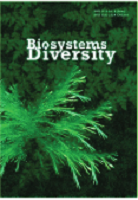Influence of hydrochemical factors on morphometric variability of Scardinius erythrophthalmus in a freshwater river system
Influence of hydrochemical factors on morphometric variability of Scardinius erythrophthalmus in a freshwater river system
Author(s): M. O. Klymenko, V. Gandziura, O. O. Biedunkova, I. I. StatnykSubject(s): Physical Geopgraphy, Environmental Geography
Published by: Дніпропетровський національний університет імені Олеся Гончара
Keywords: fish growth; age of fish; coefficient of variation; growth rate; influence of environmental factors; surface water quality;
Summary/Abstract: Studying fish growth is a complex task because growth depends on many factors. The process of fish growth is influenced by ecological factors of the water environment. Each species of fish has growth characteristics and characteristic changes in this process as a result of the action of natural and anthropogenic factors. We investigated the morphometric features of Scardinius erythrophthalmus in the hydroecosystem conditions of the Horyn River. Fish were caught by amateur fishing methods during 2018–2021 in the section of the hydrographic system of the Horyn River within the Rivne Plateau, which is the northern part of the Volhynian Upland , namely the Horyn River and its tributaries – the Zamchysko River, the Ustia River, and the Stubelka River. The catches included fish aged from 0+ (one-year-olds) to 5+ (five-year-olds). Growth variability was studied for fish aged 1+ to 4+ because their numbers were sufficient for statistical evaluation. We noticed clear features of the morphometric variability of the fish. According to the coefficient of variation for the general populations of S. erythrophthalmus from different rivers, there was mostly significant variability of such growth characteristics as the largest and smallest fish body height, total length, Smith length and short body length of fish. We also noticed the similarity of the morphometric variability of fish of different ages for the Horyn River and Stubelka River and Zamchisko River and Ustia River. The analysis and evaluation of the surface water quality of these rivers was also similar. Thus, Horyn and Stubla districts had a transitional state from II to III quality class, and the Zamchysko River and Ustya River districts had a transitional state from III to IV quality class. We conducted a multivariate regression and it revealed statistical significance and a close correlation between the coefficients of variation of the growth characteristics of fish with the phosphate content in the water (with an average value of the weighting coefficients of 0.50 ± 0.06), nitrite nitrogen (0.39 ± 0.10) and nitrate nitrogen (0.84 ± 0.34). The calculation of the specific growth of fish by full length revealed that the intensity of growth is the highest between the first and second year of life of fish for small rivers (Zamchysko River, Ustya River, Stubelka River) and between the second and third year for the Horyn River. The results presented in the article are valuable and describe the local variation in the morphometric variability of S. erythrophthalmus. This expanded the understanding of the influence of ecological factors of the aquatic environment on the formation of growth characteristics of this species of fish. In the future, our research will continue and study the linear growth of natural fish populations against the background of changes in the ecological and hydrological conditions of the studied region.
Journal: Biosystems Diversity
- Issue Year: 30/2022
- Issue No: 3
- Page Range: 244-254
- Page Count: 11
- Language: English

